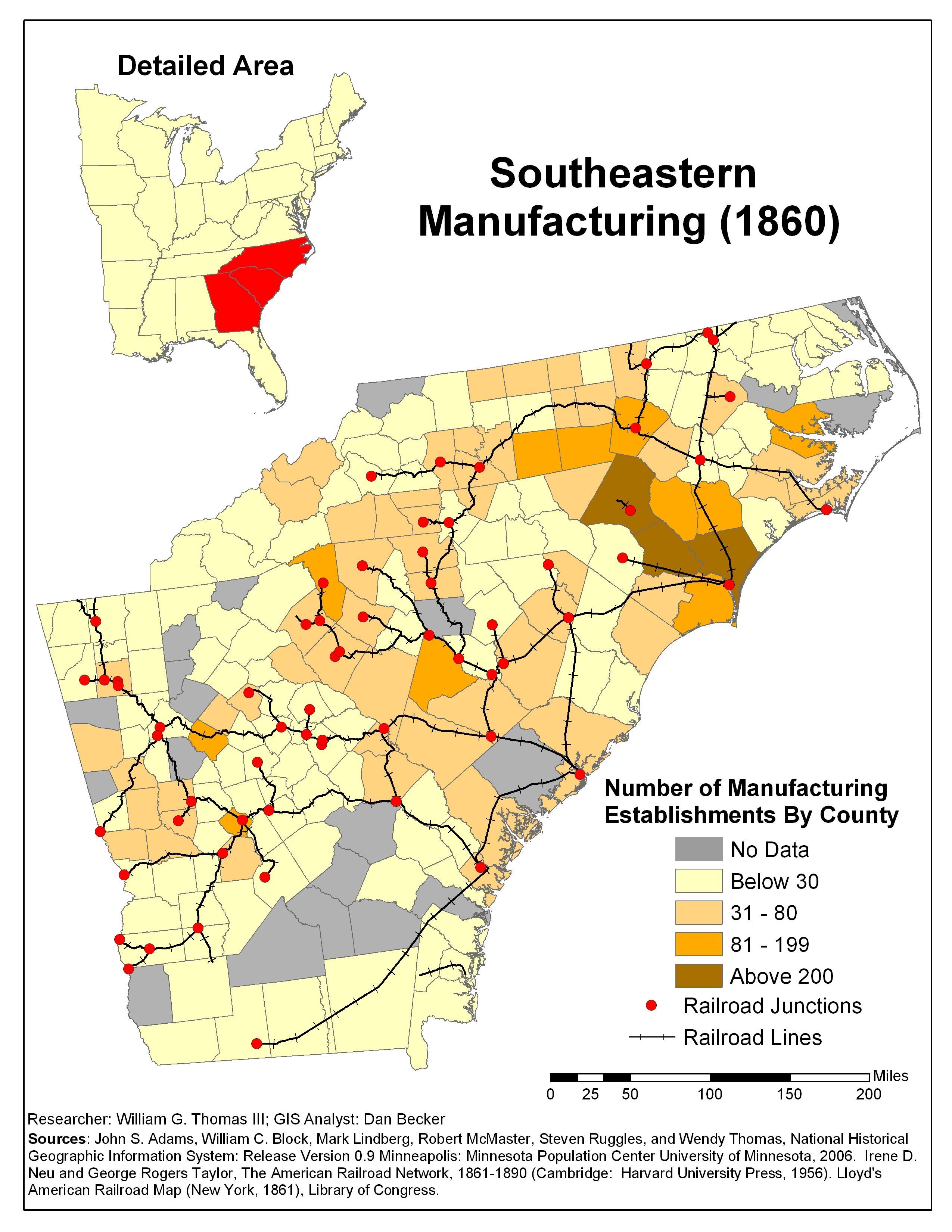The Growth of Slavery and Southern Railroad Development
- Georgia Cotton Production in 1860
- Southeastern Slave Owners, 1860
- Southeastern Slave Population, 1860
- Southeastern Farm Value, 1860
- Southeastern Investment in Manufacturing, 1860
- Southeastern Manufacturing, 1860
- New Railroad Miles Constructed by Region, 1850-1860
Southeastern Manufacturing, 1860

The number of manufacturing establishments in counties across Georgia, South Carolina, and North Carolina was highest in counties serviced by a railroad.
Keywords
- Category: Historical GIS Images
- Topic: Slavery
Related Documents
When we look closely at the South's railroad network, the South's experimentation with and investment in railroads and other technologies, it turns out, was consistent with the rest of the nation. In both regions railroads grew fastest in the new western border regions. And in both railroad development had leapfrogged over the mountain regions, leaving big gaps in some areas, such as Pennsylvania, middle Georgia, and western Virginia.
The closest studies we have of Southern subregions include Kenneth Noe's Southwest Virginia's Railroad: Modernization and the Sectional Crisis (University of Illinois Press, 1994) and Mark Wetherington's Plain Folk's Fight: The Civil War and Reconstruction in Piney Woods Georgia (University of North Carolina Press, 2005). Both indicate the intensity of railroad development even in the South's most remote regions. Slaveholding expanded in the Wiregrass and in the Appalachian mountains, and commercial agriculture developed in the wake of the railroads. The fastest growing regions of the South, especially along the western border of Texas, Arkansas, and Missouri, demonstrated just how compatible slavery was with southern railroad growth.
Southern railroad companies began buying slaves as early as the 1840s and used enslaved labor almost exclusively to construction their lines. Thousands of African Americans worked on the southern railroads in the 1850s. For African Americans the work was often the hardest, most difficult, and dangerous they were forced to undertake. Although historians, such as Allen Trelease, Robert Starobin, and Walter Licht, have acknowledged the presence of slave labor on Southern railroads, we have little sense its overall dimensions or its relationship to the southern expansionism of the 1850s. Each of these historians has found slave labor on southern railroads; more recently, Theodore Kornweibel, Jr., has documented the use of enslaved labor on 85 of 113 railroads in the Confederate states.
By 1860 the South was the third leading railroad nation in the world, trailing only the northern United States and the United Kingdom in total miles constructed. It contained 33 percent of the nation's railroad mileage and 40 percent of its population, and southern states were aggressively promoting railroad development throughout the 1850s. Indeed, southern railroads built and maintained their roads with enslaved labor, orchestrating contracts for hire on a scale of complexity and cost that seemed logical and consistent with their purposes but far in excess of any other institutions. Railroads began buying hundreds of male slaves between the ages of 16 and 35 as early as 1841, and in the 1850s were either renting or buying "hands" in groups of hundreds. One president of the Mississippi Central Railroad explained to his stockholders in 1855, "I am led to the irresistible conclusion, that in ease of management, in economy of maintenance, in certainty of execution of work & in amount of labor performed & in absence of disturbance of riotous outbreaks, the slave is preferable to free labor, and far better adapted to the construction of railways in the south."
